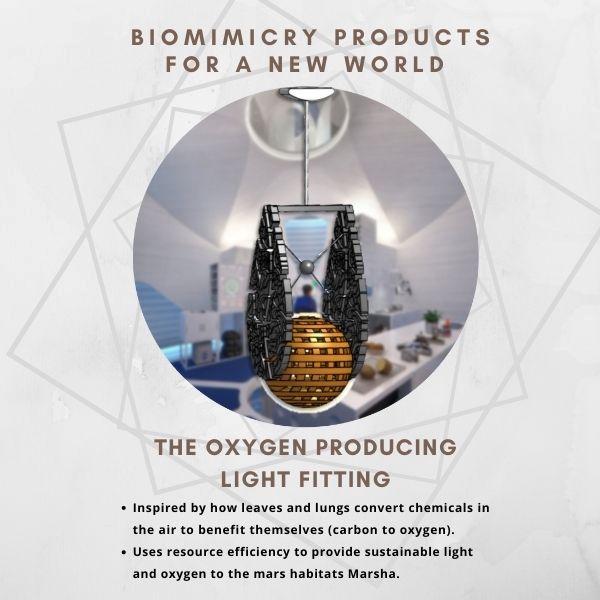
Designed for the 3D printed habitat 'Marsha', this light fitting design uses resource efficiency to provide sustainable light and oxygen for the habitats. Through being inspired by how leaves and lungs convert chemicals in the air to benefit themselves (carbon to oxygen), the design is able to produce oxygen through plasma which converts Carbon Dioxide into safe oxygen. Sustainability is upheld in the design to create an ecologically friendly habitat on mars through utilizing direct laser metal sintering (DLMS) and 3D printed Chitin-based polymers.
Full Description:
This light fitting design, alongside the chair and table design, were created for use in the newly designed Mars habitats called “Marsha”. For humans to successfully inhabit Mars and complete the goals of the mission such as observational research, resource mining, and settlement to decrease the probability of human extinction; liveability needs, and sustainability must be upheld. These liveability needs include furniture inside the habitats alongside a requirement for living on mars. The requirements I solved through these three designs are the high radiation levels on mars, intense storms and weather, and lack of safe breathing oxygen. To solve sustainability issues to produce a resource efficient environmentally friendly habitat on mars, two materials of direct laser metal sintering (DLMS) and 3D printed Chitin-based polymers were used.The first design in this series of “Biomimicry products for a new world” is a radiation detecting table design. Inspired by leaf skeletons and monkey plant’s ability to store water and detect movement, this table design unlocks when dangerous radiation levels are detected and opens to reveal life saving equipment for the emergency. The second design involves a chair design inspired by spiders’ web’s ability to detect movement and soundwaves and warns the users when a damaging mars storm will occur. The final design in this series is the oxygen producing light fitting design. This light fitting design is the most important in the series as the life requirement issue addressed is the most important, as it produces oxygen for the habitats. Alongside producing light, this design utilizes scientific Plasma materials to convert the high level of Carbon Dioxide in mars into safe breathing oxygen.
Not only does this oxygen producing light fitting design provide a life support for the mars inhabitants but has options of future applications on Earth. As some specific infrastructure on Earth requires oxygen and light, this light fitting can be utilized. Some examples of these are airplanes and helicopters flying into zones with less oxygen during the night, and submarines that require both oxygen and light underwater. Overall, utilizing a light fitting that also produces oxygen conserves space while having multi-functions. In future circumstances, habitats located underwater/ in places with a lack of oxygen and light could utilize the design, and humans can conserve space while providing the space with all necessary liveability requirements.
Overall, to create this project, I utilized my passion for sustainability to try and find ways to make a world full of environmentally friendly product designs. This passion led me to research why humans chose to travel to mars and how liveability products will be needed for the housing/habitats on mars. After finding this information, I decided to design a range of products that solve multiple issues while upholding sustainability.